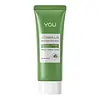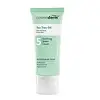What's inside
What's inside
 Key Ingredients
Key Ingredients

 Benefits
Benefits

 Concerns
Concerns

 Ingredients Side-by-side
Ingredients Side-by-side

Water
Skin ConditioningEthylhexyl Palmitate
EmollientPropylene Glycol
HumectantGlycerin
HumectantDimethicone
EmollientCetearyl Alcohol
EmollientGlyceryl Stearate
EmollientPEG-100 Stearate
Butylene Glycol
HumectantPropanediol
SolventHydroxyacetophenone
AntioxidantCarbomer
Emulsion StabilisingTriethanolamine
BufferingCetearyl Glucoside
EmulsifyingSorbitan Stearate
EmulsifyingSodium Acrylate/Sodium Acryloyldimethyl Taurate Copolymer
Emulsion StabilisingSodium Acrylates Copolymer
Pentylene Glycol
Skin ConditioningAllantoin
Skin ConditioningGalla Rhois Gallnut Extract
AntimicrobialIsohexadecane
EmollientAloe Barbadensis Leaf Juice
Skin ConditioningGentiana Scabra Root Extract
Skin ConditioningXanthan Gum
EmulsifyingCaprylhydroxamic Acid
Lecithin
EmollientCaprylic/Capric Triglyceride
MaskingPolysorbate 80
EmulsifyingDisodium EDTA
Niacinamide
SmoothingCedrus Atlantica Bark Oil
MaskingSorbitan Oleate
EmulsifyingMelaleuca Alternifolia Leaf Oil
AntioxidantPelargonium Graveolens Oil
MaskingCitrus Paradisi Peel Oil
MaskingPanthenol
Skin ConditioningEctoin
Skin ConditioningPhenoxyethanol
PreservativeTrehalose
HumectantGlyceryl Glucoside
HumectantDipotassium Glycyrrhizate
HumectantRheum Palmatum Root Extract
AstringentScutellaria Baicalensis Root Extract
AstringentPhellodendron Amurense Bark Extract
Skin ConditioningSalvia Miltiorrhiza Root Extract
Skin ConditioningEthylhexylglycerin
Skin ConditioningMadecassoside
AntioxidantAsiaticoside
AntioxidantAsiatic Acid
Skin ConditioningMadecassic Acid
Skin ConditioningCaprylyl Glycol
EmollientGlyceryl Caprylate
EmollientStephania Tetrandra Root Extract
Skin ConditioningZinc PCA
HumectantCI 19140
Cosmetic ColorantCI 17200
Cosmetic ColorantWater, Ethylhexyl Palmitate, Propylene Glycol, Glycerin, Dimethicone, Cetearyl Alcohol, Glyceryl Stearate, PEG-100 Stearate, Butylene Glycol, Propanediol, Hydroxyacetophenone, Carbomer, Triethanolamine, Cetearyl Glucoside, Sorbitan Stearate, Sodium Acrylate/Sodium Acryloyldimethyl Taurate Copolymer, Sodium Acrylates Copolymer, Pentylene Glycol, Allantoin, Galla Rhois Gallnut Extract, Isohexadecane, Aloe Barbadensis Leaf Juice, Gentiana Scabra Root Extract, Xanthan Gum, Caprylhydroxamic Acid, Lecithin, Caprylic/Capric Triglyceride, Polysorbate 80, Disodium EDTA, Niacinamide, Cedrus Atlantica Bark Oil, Sorbitan Oleate, Melaleuca Alternifolia Leaf Oil, Pelargonium Graveolens Oil, Citrus Paradisi Peel Oil, Panthenol, Ectoin, Phenoxyethanol, Trehalose, Glyceryl Glucoside, Dipotassium Glycyrrhizate, Rheum Palmatum Root Extract, Scutellaria Baicalensis Root Extract, Phellodendron Amurense Bark Extract, Salvia Miltiorrhiza Root Extract, Ethylhexylglycerin, Madecassoside, Asiaticoside, Asiatic Acid, Madecassic Acid, Caprylyl Glycol, Glyceryl Caprylate, Stephania Tetrandra Root Extract, Zinc PCA, CI 19140, CI 17200
Water
Skin ConditioningCyclopentasiloxane
EmollientNiacinamide
SmoothingAluminum Starch Octenylsuccinate
AbsorbentGlycerin
HumectantDipropylene Glycol
HumectantDimethicone
EmollientHydroxyethyl Acrylate/Sodium Acryloyldimethyl Taurate Copolymer
Emulsion StabilisingSodium Hyaluronate
HumectantTocopheryl Acetate
AntioxidantEthoxydiglycol
HumectantEthylhexyl Methoxycinnamate
UV AbsorberMelaleuca Alternifolia Leaf Oil
AntioxidantTocopherol
AntioxidantPEG-40 Hydrogenated Castor Oil
EmulsifyingDisodium EDTA
Phenoxyethanol
PreservativeSorbitan Caprylate
EmulsifyingWater, Cyclopentasiloxane, Niacinamide, Aluminum Starch Octenylsuccinate, Glycerin, Dipropylene Glycol, Dimethicone, Hydroxyethyl Acrylate/Sodium Acryloyldimethyl Taurate Copolymer, Sodium Hyaluronate, Tocopheryl Acetate, Ethoxydiglycol, Ethylhexyl Methoxycinnamate, Melaleuca Alternifolia Leaf Oil, Tocopherol, PEG-40 Hydrogenated Castor Oil, Disodium EDTA, Phenoxyethanol, Sorbitan Caprylate
 Reviews
Reviews

Ingredients Explained
These ingredients are found in both products.
Ingredients higher up in an ingredient list are typically present in a larger amount.
Dimethicone is a type of synthetic silicone created from natural materials such as quartz.
What it does:
Dimethicone comes in different viscosities:
Depending on the viscosity, dimethicone has different properties.
Ingredients lists don't always show which type is used, so we recommend reaching out to the brand if you have questions about the viscosity.
This ingredient is unlikely to cause irritation because it does not get absorbed into skin. However, people with silicone allergies should be careful about using this ingredient.
Note: Dimethicone may contribute to pilling. This is because it is not oil or water soluble, so pilling may occur when layered with products. When mixed with heavy oils in a formula, the outcome is also quite greasy.
Learn more about DimethiconeDisodium EDTA plays a role in making products more stable by aiding other preservatives.
It is a chelating agent, meaning it neutralizes metal ions that may be found in a product.
Disodium EDTA is a salt of edetic acid and is found to be safe in cosmetic ingredients.
Learn more about Disodium EDTAGlycerin is already naturally found in your skin. It helps moisturize and protect your skin.
A study from 2016 found glycerin to be more effective as a humectant than AHAs and hyaluronic acid.
As a humectant, it helps the skin stay hydrated by pulling moisture to your skin. The low molecular weight of glycerin allows it to pull moisture into the deeper layers of your skin.
Hydrated skin improves your skin barrier; Your skin barrier helps protect against irritants and bacteria.
Glycerin has also been found to have antimicrobial and antiviral properties. Due to these properties, glycerin is often used in wound and burn treatments.
In cosmetics, glycerin is usually derived from plants such as soybean or palm. However, it can also be sourced from animals, such as tallow or animal fat.
This ingredient is organic, colorless, odorless, and non-toxic.
Glycerin is the name for this ingredient in American English. British English uses Glycerol/Glycerine.
Learn more about GlycerinThis tea tree oil comes from the leaves of the Tea Tree plant. Tea tree oil has antioxidant, anti-inflammatory, and antimicrobial properties.
According to the book Journal of Profiles of Drug Substances, tea tree helps in reducing acne-causing bacteria such as Propionibacterium acnes. This is due to the Terpinen components of tea tree oil.
Tea tree may cause sensitivity and irritation for some people. This oil naturally contains fragrance such as linalool and limonene.
However, research shows irritation usually occurs when using pure tea tree oil and not in cosmetic products.
Tea tree oil was found to help relieve the symptoms of psoriasis in one study.
Tea tree oil is toxic when ingested. Another study showed it to caused damage to the nervous system of dogs and cats when applied to their skin or given orally.
Learn more about Melaleuca Alternifolia Leaf OilNiacinamide is a multitasking form of vitamin B3 that strengthens the skin barrier, reduces pores and dark spots, regulates oil, and improves signs of aging.
And the best part? It's gentle and well-tolerated by most skin types, including sensitive and reactive skin.
You might have heard of "niacin flush", or the reddening of skin that causes itchiness. Niacinamide has not been found to cause this.
In very rare cases, some individuals may not be able to tolerate niacinamide at all or experience an allergic reaction to it.
If you are experiencing flaking, irritation, and dryness with this ingredient, be sure to double check all your products as this ingredient can be found in all categories of skincare.
When incorporating niacinamide into your routine, look out for concentration amounts. Typically, 5% niacinamide provides benefits such as fading dark spots. However, if you have sensitive skin, it is better to begin with a smaller concentration.
When you apply niacinamide to your skin, your body converts it into nicotinamide adenine dinucleotide (NAD). NAD is an essential coenzyme that is already found in your cells as "fuel" and powers countless biological processes.
In your skin, NAD helps repair cell damage, produce new healthy cells, support collagen production, strengthen the skin barrier, and fight environmental stressors (like UV and pollution).
Our natural NAD levels start to decline with age, leading to slower skin repair, visible aging, and a weaker skin barrier. By providing your skin niacinamide, you're recharging your skin's NAD levels. This leads to stronger, healthier, and younger looking skin.
Another name for vitamin B3 is nicotinamide. This vitamin is water-soluble and our bodies don't store it. We obtain Vitamin B3 from either food or skincare. Meat, fish, wheat, yeast, and leafy greens contain vitamin B3.
The type of niacinamide used in skincare is synthetically created.
Learn more about NiacinamidePhenoxyethanol is a preservative that has germicide, antimicrobial, and aromatic properties. Studies show that phenoxyethanol can prevent microbial growth. By itself, it has a scent that is similar to that of a rose.
It's often used in formulations along with Caprylyl Glycol to preserve the shelf life of products.
Water. It's the most common cosmetic ingredient of all. You'll usually see it at the top of ingredient lists, meaning that it makes up the largest part of the product.
So why is it so popular? Water most often acts as a solvent - this means that it helps dissolve other ingredients into the formulation.
You'll also recognize water as that liquid we all need to stay alive. If you see this, drink a glass of water. Stay hydrated!
Learn more about Water